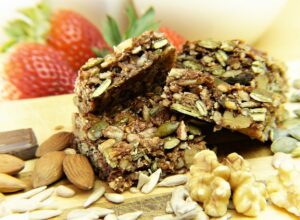5 Reasons Why Your Snack Bar May Not Be Your Friend
In a recent conversation, the topic of cereal/granola/protein bars came up. They appear to be a healthy snack, especially for a very busy person who is always on the go.
Spoiler alert. A high number of them are no better than your favorite candy bar. 
5 Reasons Why Your Snack Bar May Not Be Your Friend
1. High sugar content. Check out ADDED sugars. Fruit has sugar because God made it sweet, so that’s not the number to be concerned with here. Added sugars are in your bar because of sugar, corn syrup, honey, etc. This number needs to be on the low side—no more than 10 grams. Keep this in mind: The AHA suggests an added-sugar limit of no more than 100 calories per day (about 6 teaspoons or 24 grams of sugar) for most women and no more than 150 calories per day (about 9 teaspoons or 36 grams of sugar) for most men.
2. Low protein. In order for that bar to help sustain you, look for protein content of 5 grams or more. A bar high in sugar and low in protein may set you up for a dip in energy later.
3. Low fiber. The greater the fiber content, the longer you’ll stay full so that you can be productive until your next meal. Look for 3 grams or more. Adults 50 and younger need 25 grams/day for women and 38 grams for men. Over age 50 need 21 grams and 30 grams respectively. (It’s about the same number as maximum added-sugar intake, so easy to remember.)
4. Unhealthy fats. Avoid bars with trans fat. It’s important to read the ingredients for this, because even if the number reads zero grams, it’s not always the case. If you read partially hydrogenated oil, margarine, or shortening, do not buy it or eat it.
5. Too many weird ingredients. Look for more whole foods and fewer ingredients that leave you wondering what they are. Nuts, seeds, dried fruits, and oats are good.
I’ve found that RX Bars are pretty clean. Although the sugar content is high, it’s from dates, not added sugars.
Oh, and by the way, the 5 reasons are a good standard for any food that comes with a label.
***************
Baby at week #30 is the size of a large head of cabbage, which is about the size and shape of a person’s head. Very clever.
Cabbage belongs to the same group as broccoli, Brussels sprouts, and kale, known as the Brassica family. 
It is inexpensive, easy to store, and is an excellent source of vitamins C and K, folate, and a great source of protective phytochemicals.
Cabbage is available in different varieties and colors: Savoy, Napa or Chinese; green, red, purple, and white.
It can be fermented (as in kimchi or sauerkraut) or cooked in a variety of ways, including steamed, sautéed, braised, or stuffed. Toss it into soups.
I remember my mom and grandma making delicious stuffed cabbage when I was young. (If you have an amazing recipe for this, please share it with me.)
To get the greatest nutritional benefits, eat raw or steamed (not microwaved).
Steaming cabbage is simple. Slice in whatever way you’d like, place in a steamer basket over boiling water, and allow to cook, covered, until tender. Add a bit of salt, pepper, and oil or butter, along with any herbs or flavorings you might like, and serve.
To enjoy it raw, here’s a recipe I found to share with you. Alter it as you wish.
Red Cabbage Slaw
1 head red cabbage, shaved
½ head broccoli, shaved
1 green onion, sliced
1 handful cherry tomatoes, cut in half
3 baby dill pickles, chopped
1 cup mixed herb leaves (parsley, cilantro, basil)
1 Tablespoon grainy mustard
1 Tablespoon extra-virgin olive oil
½ lemon, juiced
½ teaspoon salt
Cracked pepper
Begin by shaving the cabbage and broccoli and cutting up the onion, tomatoes, and dill pickles.
Next, in a large bowl, combine the olive oil, mustard, lemon juice, and salt. Add the cabbage and toss until mixed. Finally, add the broccoli, onion, pickles, tomatoes, and herbs. Toss gently until combined. Sprinkle with cracked pepper. Makes 8 servings.
Sending love and snow angels,
Carol
“When it snows, you have two choices: shovel or make snow angels.”–Unknown


